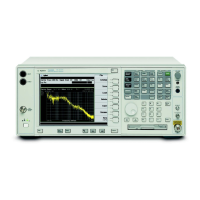Chapter 4 207
Instrument Functions: P - Z
Peak Search
Instrument Functions: P - Z
4.1.8.1 Peak Excursn
Sets the minimum amplitude variation of signals that the marker can identify as a
separate peak. For example, if a peak excursion value of 10 dB is selected, the marker
Next
Peak
function moves only to peaks that rise more than 10 dB above the Peak Threshold and
then fall back down by at least the
Peak Excursn. This criteria applies to all traces. This
function applies to
Next Peak, Next Peak Left, and Next Peak Right. If Peak Search is set to
Param, it also applies to
Peak Search.
Key Path:
Peak Search, Search Param
Dependencies/
Couplings: This function is not available when
Y-Axis is set to Frequency instead of
Amplitude.
State Saved: Saved in instrument state.
Factory Preset: 6.0 dB
Factory
Default: 6.0 dB
Terminators: dB
Default Terminator: dB
Resolution/
Rounding/
Truncation: 0.01 dB
Knob Increment: 1 dB
Step Key
Increment: 1 dB
Range: 0.0 dB to 100 dB
Remote Command:
:CALCulate:MARKer[1]|2|3|4:PEAK:EXCursion <rel_amplitude>
UP|DOWN|MIN|MAX|DEFault
:CALCulate:MARKer[1]|2|3|4:PEAK:EXCursion?
Remote Command Notes: CALC:MARK:PEAK:SEAR:MODE must be set to PARameter
ig you want Peak Search to take advantage of the threshold excursion.
Example:
:CALC:MARK:PEAK:EXC 30 DB sets the minimum peak excursion
requirement to 30 dB.
See the full example for the CALC:MARK:PEAK:SEAR:MODE command
below.

